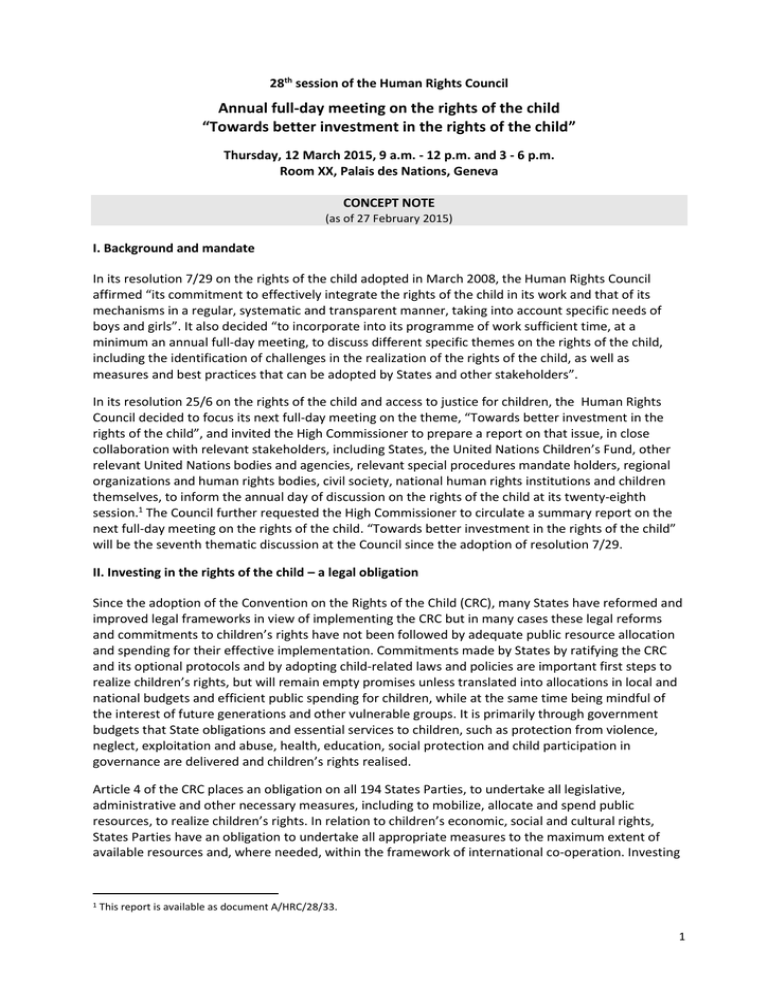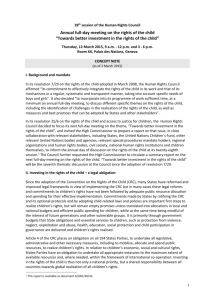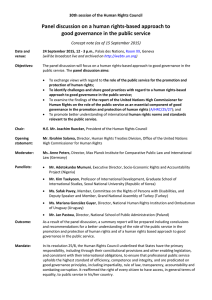Annual full-day meeting on the rights of the child
advertisement

28th session of the Human Rights Council Annual full-day meeting on the rights of the child “Towards better investment in the rights of the child” Thursday, 12 March 2015, 9 a.m. - 12 p.m. and 3 - 6 p.m. Room XX, Palais des Nations, Geneva CONCEPT NOTE (as of 27 February 2015) I. Background and mandate In its resolution 7/29 on the rights of the child adopted in March 2008, the Human Rights Council affirmed “its commitment to effectively integrate the rights of the child in its work and that of its mechanisms in a regular, systematic and transparent manner, taking into account specific needs of boys and girls”. It also decided “to incorporate into its programme of work sufficient time, at a minimum an annual full-day meeting, to discuss different specific themes on the rights of the child, including the identification of challenges in the realization of the rights of the child, as well as measures and best practices that can be adopted by States and other stakeholders”. In its resolution 25/6 on the rights of the child and access to justice for children, the Human Rights Council decided to focus its next full-day meeting on the theme, “Towards better investment in the rights of the child”, and invited the High Commissioner to prepare a report on that issue, in close collaboration with relevant stakeholders, including States, the United Nations Children’s Fund, other relevant United Nations bodies and agencies, relevant special procedures mandate holders, regional organizations and human rights bodies, civil society, national human rights institutions and children themselves, to inform the annual day of discussion on the rights of the child at its twenty-eighth session.1 The Council further requested the High Commissioner to circulate a summary report on the next full-day meeting on the rights of the child. “Towards better investment in the rights of the child” will be the seventh thematic discussion at the Council since the adoption of resolution 7/29. II. Investing in the rights of the child – a legal obligation Since the adoption of the Convention on the Rights of the Child (CRC), many States have reformed and improved legal frameworks in view of implementing the CRC but in many cases these legal reforms and commitments to children’s rights have not been followed by adequate public resource allocation and spending for their effective implementation. Commitments made by States by ratifying the CRC and its optional protocols and by adopting child-related laws and policies are important first steps to realize children’s rights, but will remain empty promises unless translated into allocations in local and national budgets and efficient public spending for children, while at the same time being mindful of the interest of future generations and other vulnerable groups. It is primarily through government budgets that State obligations and essential services to children, such as protection from violence, neglect, exploitation and abuse, health, education, social protection and child participation in governance are delivered and children’s rights realised. Article 4 of the CRC places an obligation on all 194 States Parties, to undertake all legislative, administrative and other necessary measures, including to mobilize, allocate and spend public resources, to realize children’s rights. In relation to children’s economic, social and cultural rights, States Parties have an obligation to undertake all appropriate measures to the maximum extent of available resources and, where needed, within the framework of international co-operation. Investing 1 This report is available as document A/HRC/28/33. 1 in the rights of the child is thus not only a national priority, but a shared responsibility between all countries towards global realization of all children’s rights. Investment in the rights of children is not only a legal obligation for all countries, regardless of the economic circumstances, but also an economic strategy for long-term sustainable development. As the General Assembly emphasised in “A World Fit for Children”, investing in the rights of children lays the foundation for a just society, a strong economy, and a world free of poverty. 2 Conversely, inadequate investment, especially in the most vulnerable and marginalised, can perpetuate the intergenerational transmission of poverty and lead to irreversible negative impacts on children’s development.3 The lack of sufficient, effective and efficient public spending on children is one of the biggest barriers to the realisation of children’s rights. Children’s rights and their best interests are generally not a primary consideration in budgetary decisions and as a result are not prioritised in policy implementation. Moreover, the global financial and economic crisis, which was followed by a wave of austerity measures, including severe budget cuts in social sectors, is also having a serious impact on children and families worldwide, with the rise in the proportion of those living in poverty and social exclusion. Investment in the realization of children’s rights is not only about securing adequate resource allocation, but also about improving the quality of public spending. Transparent fiscal processes where citizens, including children, can actively participate in the different stages of the budget cycle based on access to comprehensive, timely, and disaggregated information, making budget allocations and expenditures for children visible, is crucial to ensure accountability of States for managing public resources efficiently and effectively and to limit corruption and leakages. The importance of resources for children’s rights was repeatedly emphasised in several thematic reports from the Office of the High Commissioner for Human Rights4, Special Procedures5 and Human Rights Council resolutions, including resolution 22/32 on “the right of the child to the enjoyment of the highest attainable standard of health” which encouraged “the implementation of rights-based budget monitoring and analysis for expenditure on children in general, especially child health”. Good governance has also been highlighted as a key factor to realize human rights6 and is particularly relevant in the context of investment in the rights of the child. III. Focus and objectives The annual full-day meeting will constitute one of the first international fora where investment in the realization of children’s rights will be comprehensively discussed, building upon the Day of General Discussion on "Resources for the Rights of the Child - Responsibility of States" held by the Committee on the Rights of the Child in 2007. It will provide an important opportunity to discuss investment in children as a key human rights issue from a range of perspectives. The annual day of discussion will: Draw the links between policy development, resources for children, transparent, participatory, easily accessible and accountable governance and realization of children’s rights. 2 A World Fit for Children (General Assembly resolution S-27/2), [50]. Report of the Secretary-General on the status of the Convention on the Rights of the Child (A/68/257), [74]. 4 For example, see paragraph 54 (i) in A/HRC/26/22, Report of the Office of the United Nations High Commissioner for Human Rights on preventing and eliminating child, early and forced marriage. 5 For example, see A/HRC/26/28, Report of the Special Rapporteur on extreme poverty and human rights (2014). 6 Human Rights Council resolution 19/20 (19 March 2012) on “The role of good governance in the promotion and protection of human rights”. 3 2 Discuss what a child rights-based approach to budgeting means and how the four key general principles of the CRC can be operationalised into all the stages of fiscal processes, including resource mobilization, allocation, spending, monitoring and evaluation for children’s rights. Identify current challenges to investment in the rights of children and ways to overcome them. Share good practices and examples in relation to investment in the rights of children, including on how to ensure the voices of children in all stages of the budget cycle. Highlight practical recommendations for States on how to ensure more accountable, transparent, efficient, equitable, inclusive and sustainable investment in children’s rights. Explore how investment in the rights of the child can be taken into account and integrated in existing initiatives and processes, including the post-2015 agenda and financing for development discussions. IV. Programme Morning panel (9 a.m. - 12 p.m.) From rights in theory to rights in practice: overview of key aspects and challenges in planning, mobilizing, allocating and spending public resources to realize children’s rights Chair: H.E. Mr. Joachim Ruecker, President of the Human Rights Council Opening statement: Ms. Jane Connors, Director, Research and Right to Development Division, Office of the United Nations High Commissioner for Human Rights Children’s voices video (3 minutes) Moderator: H.E. Mr. Ricardo González Arenas, Ambassador and Permanent Representative of Uruguay to the United Nations Office and other international organizations in Geneva What is investment in the rights of the child and why is it important? Mr. Bob Muchabaiwa, Investment in Children Manager, Save the Children Overview of existing norms and standards and key aspects and challenges in applying a child rights approach across the budget cycle Mr. Jorge Cardona, Member, Committee on the Rights of the Child Key aspects and challenges in ensuring investment in the rights of the child based on principles of transparent, participatory, inclusive and accountable governance Ms. Shaamela Cassiem, Manager, International Training, International Budget Partnership Reporting, monitoring and accountability for investment in the realization of children’s rights Ms. Jingqing Chai, Chief, Public Finance and Governance, Social Inclusion and Policy section, Programming Division, United Nations Children's Fund Afternoon panel (3 - 6 p.m.) Applying a rights-based approach to investment in children and strengthening accountability –Focus on concrete examples of strategies and good practices. Chair: H.E. Mr. Joachim Ruecker, President of the Human Rights Council Opening statement: Ms. Amina Mohammed, Special Advisor of the Secretary-General on Post-2015 Development Planning Moderator: H.E. Mr. Peter Sørensen, Ambassador and Head of the Permanent Delegation of the European Union to the United Nations Office and other international organizations in Geneva 3 Children as actors in accountability for investment in children Ms. Stefanie Conrad, Global Advisor for Citizenship & Governance, Plan international Challenges and good practices for ensuring sufficient, efficient and equitable investment in children’s rights: o Representative from the Ministry of Finance of Bangladesh o Mr. Enrique Vásquez, Director of Social Investment Management Master’s program at Universidad del Pacífico and Executive Director of the Peruvian University Consortium o Mr. Marc Dullaert, Chair Elect of the European Network of Ombudspersons for Children, Children’s Ombudsman of the Netherlands o Mr. Yehualashet Mekonen, Head of the African Child Observatory, African Child Policy Forum V. Modalities The morning panel will help to gain clarity on the fundaments of investing in children. It will provide an overview of key aspects of investment in children, discuss existing norms and standards and identify key challenges in planning, mobilizing, allocating and spending public resources to realize children’s rights. The afternoon panel will focus on illustrating how the process of investing in children can be conducted in a manner respectful of human rights principles at local, national, regional and international levels. It will do so by highlighting initiatives and good practices related to investment in children based on principles of transparent, participatory and accountable systems and structures of governance that provides space for children’s active involvement. The duration of each panel is three hours. The opening addresses and the presentations by the panellists will be followed by an interactive discussion. Panellists will be representing governments, United Nations agencies and bodies, independent national human rights institutions (NHRIs), nongovernmental organizations (NGOs) working with and for children, and academia from all regions. They will have 5-7 minutes for their initial presentation and will then react to specific questions from the floor. The interactive discussion will be divided into two segments of 60 minutes each (45 minutes for comments and questions from the floor from States, NHRIs and NGOs, followed by 15 minutes for comments and replies by panellists). States, NHRIs and NGOs are encouraged to intervene in the debate through questions and comments directly linked to the interventions of the panellists. Speaking time for interventions by Members and observers will be limited to two minutes in order to allow a maximum of speakers to intervene. The interactive discussion will be followed by concluding remarks from the panellists. Children’s voices: At the beginning of the annual day, a video with input from children who participated in global consultation exercises on investment in children will be shown in the Human Rights Council room. VI. Outcome The annual full-day meeting will identify common obstacles and challenges for investment in the rights of the child within frameworks of transparent, participatory, inclusive and accountable governance; recommend solutions and ways forward for States; and provide suggestions as to how the issue can be further integrated and mainstreamed in the United Nations agenda. A summary of the annual day of discussion will be posted on the OHCHR website. 4 VII. Background documents Human Rights Council resolution 7/29 on the rights of the child Human Rights Council resolution 25/6 on rights of the child: access to justice for children Towards better investment in the rights of the child - Report of the United Nations High Commissioner for Human Rights Report of (A/HRC/28/33) 5


